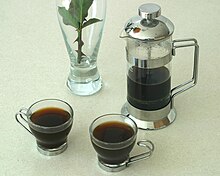French press

A French press, also known as a cafetière, сafetière à piston, Cafeteria, press pot, coffee press, or coffee plunger, is a coffee brewing device patented by Italian designer Attilio Calimani in 1929.[1]
Nomenclature
The French press goes by various names around the world. In Italy the press is known as a caffettiera a stantuffo. In New Zealand, Australia, and South Africa the apparatus is known as a coffee plunger, and coffee brewed in it as plunger coffee. Its French name is cafetière à piston, though French speakers also use genericized trademarks, notably Melior or Bodum. In the UK and the Netherlands the device is known as a cafetière, the French word for coffee maker or pot. In the United States and Canada, it is known as a French press or coffee press.
History and design

Over the years, the French press has undergone several design modifications. The first coffee press, which may have been made in France, was the modern coffee press in its rudimentary form: a metal or cheesecloth screen fitted to a rod that users would press into a pot of boiling water. The coffee press was patented by Milanese designer Attilio Calimani in 1929. It underwent several design modifications through Faliero Bondanini, who patented his own version in 1958 and began manufacturing it in a French clarinet factory called Martin SA, where its popularity grew. The device was further popularized across Europe by a British company by the name of Household Articles Ltd., and most notably, the Danish tableware and kitchenware company, Bodum.
The modern French press consists of a narrow cylindrical beaker, usually made of glass or clear plastic, equipped with a metal or plastic lid and plunger that fits tightly in the cylinder and has a fine wire or nylon mesh filter.
Preparation
A French press requires coffee of a coarser grind than does a drip brew coffee filter, as finer grounds, when immersed in water, have lower permeability than coarser grounds, requiring an excessive and potentially dangerous amount of force to be applied by hand to lower the plunger. In addition, finely-ground coffee is more likely to seep through or around the perimeter of the press filter and into the coffee.[2] Coffee is brewed by placing the ground coffee in the empty beaker and adding hot (93-96 degrees Celsius, 200-205 degrees Fahrenheit) water, in proportions of about 28 grams (1 ounce) of coffee grounds to 450 ml (15 fluid ounces) of water, more or less to taste. The water is added and then covered and allowed to brew. The total brewing time from beginning to end is about two to four minutes, depending on the size of the press. The plunger is pressed to separate the grounds and hold them at the bottom of the beaker and the brew is poured out. One may wish to decant the coffee into a serving vessel at this point; if the brewed coffee is allowed to remain in the beaker with the used grounds, the coffee can become astringent and bitter, though this is an effect that some users of the French press consider desirable. It is widely believed that the optimum time for brewing the coffee is around 4 minutes. Others consider the coffee spoiled after about 20 minutes.[3] Other approaches, such as cold-brewing, require several hours of contact between the water and the grounds to achieve the desired extraction.
Variations
French presses are more portable and self-contained than other coffee makers. Travel mug versions exist, which are made of tough plastic instead of the more common glass, and have a sealed lid with a closable drinking hole. Some versions are marketed to hikers and backpackers not wishing to carry a heavy, metal percolator or a filter using drip brew. Other versions include stainless steel, insulated presses designed to keep the coffee hot, similar in design to thermos flasks. One variation uses a "pull" design: the coffee grounds are placed in a mesh basket, which is then pulled into the lid after brewing, trapping the grounds out of the coffee. Others produce a similar effect by having shutters that can be closed via the top of the press, sealing the grounds off from the coffee entirely. French presses are also sometimes used to make cold brew coffee.
Tea
In the same way as coffee, a French press can also be used in place of a tea infuser to brew loose tea. The tea will continue to steep even after the plunger is depressed, which may cause the tea remaining in the press to become excessively bitter. This can be prevented by pouring the tea into a teapot instead of directly pouring it into the cup.
See also
References
- ^ Grierson, James, "History of the Cafetière", Coffee knowledge, UK: Galla coffee, retrieved 2009-12-23
- ^ Millman, China (2009-04-23). "Freshen Up; Manual Brewing Techniques Give Coffee Lovers a Better Way to Make a Quality Drink". Pittsburgh Post-Gazette. Retrieved 2009-06-16.
- ^ Rinsky, Laura Halpin (2008). The Pastry Chef's Companion. John Wiley & Sons. p. 119. ISBN 978-0-470-00955-0.
External links
 The dictionary definition of French press at Wiktionary
The dictionary definition of French press at Wiktionary
